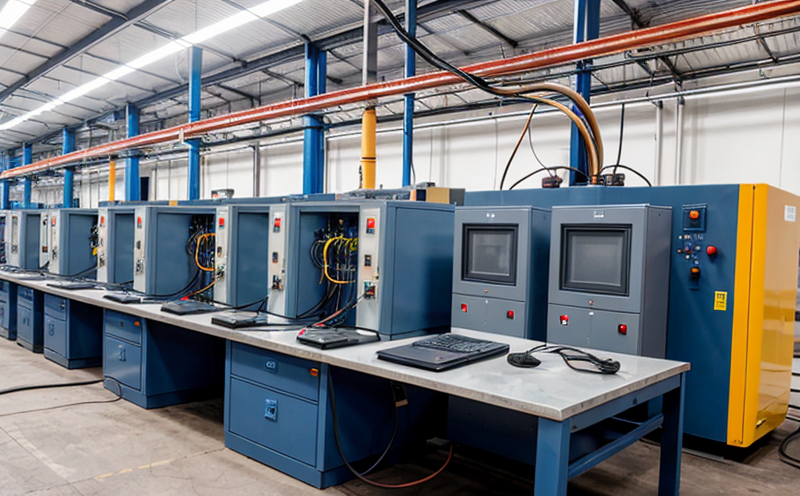IEC 62471 Photobiological Safety Testing of Control Lighting
The IEC (International Electrotechnical Commission) 62471 standard addresses the photobiological safety requirements for control lighting. This testing ensures that light sources, including those used in industrial settings, meet stringent safety standards to prevent harmful effects on human health and well-being.
Control lighting is critical in various industrial environments where it must perform reliably under challenging conditions. The IEC 62471 standard provides a framework for testing the photobiological safety of these light sources by assessing their potential hazards from visible, ultraviolet (UV), and infrared radiation. This ensures that workers in industrial settings are not exposed to excessive levels of harmful light.
The testing process involves several key steps. Specimens are prepared according to the standard's specifications, which may include different types of control lighting fixtures used across various sectors like manufacturing, processing, and other industrial applications. The apparatus required for this test includes specialized photometers capable of measuring the intensity and spectral distribution of light.
The testing criteria are stringent and ensure compliance with international standards. Compliance is critical in ensuring that products meet safety requirements set by regulatory bodies worldwide. This ensures a level playing field and protects consumers from potentially harmful products.
Understanding the real-world applications of this test is crucial for those involved in industrial manufacturing and processing testing. For instance, it helps ensure that control lighting in automated systems functions safely without causing adverse effects on personnel. Compliance with IEC 62471 can also facilitate smoother international trade by ensuring compatibility across different regions.
Real-world scenarios where this test is essential include the design and manufacturing of industrial machinery, process control units, and other equipment that incorporate control lighting systems. By adhering to these standards, manufacturers can enhance their products' safety, reliability, and marketability.
The IEC 62471 standard's photobiological safety testing is a critical component in the quality assurance processes of industrial manufacturing and processing facilities. It ensures that control lighting systems are safe for use in hazardous environments where workers may be exposed to harmful light sources. This testing not only protects worker health but also contributes to overall operational efficiency by reducing incidents related to lighting-induced hazards.
Compliance with IEC 62471 is increasingly becoming a requirement for manufacturers aiming to meet global standards and gain international acceptance of their products. By incorporating this test into their quality assurance protocols, companies can ensure that their control lighting systems are safe and reliable, thereby enhancing their reputation in the market.
The IEC 62471 standard's emphasis on photobiological safety is particularly relevant for industrial environments where lighting plays a crucial role in both operational efficiency and worker safety. By adhering to these stringent testing protocols, manufacturers can ensure that their products meet international standards and are safe for use across various sectors.
Why Choose This Test
Choosing IEC 62471 photobiological safety testing is essential for ensuring the reliability and safety of control lighting systems in industrial settings. This test guarantees that light sources comply with international standards, protecting workers from potential harm caused by excessive exposure to harmful light.
- The primary advantage of this testing is its ability to ensure compliance with IEC 62471, which sets stringent safety criteria for control lighting.
- By choosing this test, manufacturers can enhance their reputation and marketability by demonstrating a commitment to high-quality standards.
- Compliance with these standards facilitates smoother international trade and ensures compatibility across different regions.
- This testing process also helps in identifying potential hazards early in the product development cycle, allowing for necessary modifications before full-scale production.
The test is particularly advantageous for industrial manufacturers looking to ensure their products meet global standards. It provides peace of mind knowing that control lighting systems are safe and reliable, enhancing overall operational efficiency and worker safety.
Quality and Reliability Assurance
The IEC 62471 photobiological safety testing is a crucial component in the quality assurance processes of industrial manufacturing and processing facilities. By adhering to this standard, manufacturers can ensure that their control lighting systems are safe and reliable, thereby enhancing their reputation in the market.
Quality and reliability assurance through IEC 62471 testing involves several key steps. Specimens must be prepared according to the standard's specifications, which may include different types of control lighting fixtures used across various sectors like manufacturing, processing, and other industrial applications. The apparatus required for this test includes specialized photometers capable of measuring the intensity and spectral distribution of light.
The testing criteria are stringent and ensure compliance with international standards. This ensures that products meet safety requirements set by regulatory bodies worldwide. Compliance is critical in ensuring a level playing field and protecting consumers from potentially harmful products.
Understanding the real-world applications of this test is crucial for those involved in industrial manufacturing and processing testing. For instance, it helps ensure that control lighting in automated systems functions safely without causing adverse effects on personnel. By adhering to these standards, manufacturers can enhance their products' safety, reliability, and marketability.
The IEC 62471 standard's photobiological safety testing is particularly relevant for industrial environments where lighting plays a crucial role in both operational efficiency and worker safety. This testing not only protects worker health but also contributes to overall operational efficiency by reducing incidents related to lighting-induced hazards.





